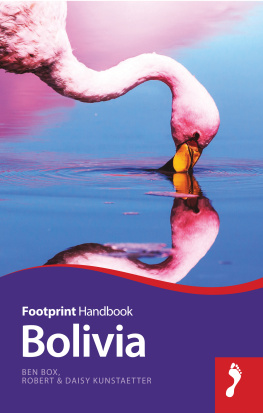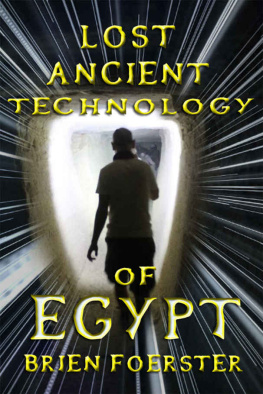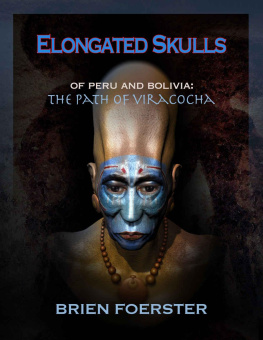
Lost Ancient Technology
Of Peru And Bolivia
Copyright Brien Foerster 2012
All photos in this book as well as text other than that of the author are assumed to be copyright free; obtained from internet free file sharing sites.

Dedication
To those that came before us and left a legacy in stone that we are trying to comprehend. Although many archaeologists dont like people outside of their field digging into the past so to speak when conventional explanations dont satisfy, I feel it is essential. If the engineering feats of the Ancient Ones cannot or indeed are not answered satisfactorily, if the age of these stone works dont include consultation from geologists, and if the oral traditions of those that are supposedly descendants of the master builders are not taken into account, then the full story is not present.
One of the best examples of this regards the great Sphinx of Egypt, dated by most Egyptologists at about 4500 years. It took the insight and questioning mind of John Anthony West, veteran student of the history of that great land to invite a geologist to study the weathering patterns of the Sphinx and make an estimate of when and how such degradation took place. In stepped Dr. Robert Schoch, PhD at Boston University, who claimed, and still holds to the theory that such an effect was the result of rain, which could have only occurred prior to the time when the Pharaoh, the presumed builders, had existed.
And it has taken the keen observations of an engineer, Christopher Dunn , to look at the Great Pyramid on the Giza Plateau and develop a very potent theory that it was indeed not the tomb of an egotistical Egyptian ruler, as in Khufu, but an electrical power plant that functioned on a grand scale thousands of years before Khufu (also known as Cheops) was born.
I salute such brave people , as well as Graham Hancock, Robert Bauval, Stephen Mehler and many others who boldly use observation and logic to break through paradigms which have run their course and frankly no longer work. The only way to truly understand the brilliance of our collective ancestors is to approach what they have left behind for us in a systematic and multi-disciplinary way. A complete understanding requires a holistic approach.
In the case of Peru and Bolivia, there are neither the fire storms of disagreement nor the extensive analysis of historical artifacts as seen in Egypt. In some ways this is both a blessing and a curse for me; I am blessed to be able to study megalithic and other works without much opposition, but in some ways cursed by having to o few academics and experts to draw from. The search goes on, and this is my first treatise on trying to figure out when and how all of the amazing and puzzling stone masterworks of Peru and Bolivia were, but not my last. Thanks especially to Christopher Dunn, Dan Guthrie, Arlan Andrews and Mike Mahar for lending their engineering wisdom and knowledge in the field, and my beloved Irene for never allowing me to quit.
Foreword
by Dr. Arlan Andrews, Sr., P.E.
A wise man once said, "The best teacher is one who shows you where to look, but does not tell you what to see." Although Brien Foerster does not claim to be a "teacher," he is indeed one who can show you where to look, but will not tell you what to see. Traveling through the Sacred Valley and other places in Peru with Brien is an absolute delight; you know that you will experience quite a different journey than any ordinary tourist could, and will begin to sense the mystery and majesty of layers of ancient civilizations. And start to wonder at the obvious mysteries laid out before you.
During our ten days in Peru in April 2012, Brien took my son Sean and me not only to the usual tourist-infested public sites, but also to many off-road (and uphill!) unique huacas that international visitors seldom see. He pointed out various symbols and patterns that were suggestive of ancient meanings, but left the interpretations to us. He participated with us as we speculated on the uses and inte r pretations of various stone works, carvings and architectural configurations. And co-wrote an article with us, "Three Courses to Cusco", which may yet be published in ATLANTIS RISING MAGAZINE.
In the evenings, over a few brews, Brien would sometimes offer up his own inner feelings about the marvelous ruins we had crawled over and through that day, but always as his own personal insights, never demanding acceptance, only a hearing. His belief that some of the structures we had seen were well over 10,000 years old has been given credibility by reports in November 2012 that archaeologists had proven that some of the Peruvian coastal sites have been dated back to nearly 14,000 years ago. Again, it seems that every new discovery drives the antiquity of the ancients further and further back into the past. On this point, Brien and I agree that the major discoveries are yet to come, especially as we find out how the stone works were fabricated. As Brien quotes me in this book: "Explaining lost ancient technology depends in large part on finding lost ancient tools."
Although only lightly touched upon in this book, Brien's passion for the Elongated Skull Peoples of ancient Peru may yet bring new understanding to a subject that all others have either neglected or ignored. It may well be that the "Lost Ancient Technology of Peru and Bolivia" depended as much on "lost ancient peoples" as it did on "lost ancient tools." If that turns out to be the case, then Brien will deserve credit for demanding that the archaeological world -- and indeed, all humanity --pay attention.
Another wise man once said, "Imagination is looking at what others have looked at, but seeing what others have not seen."
Thank you, Brien Foerster, for your knowledge and your imagination.
Table Of Contents
1/ Introduction
2/ Sachsayhuaman
3/ Qenqo
4/ Amaru Machay
5/ Coricancha
6/ Inca Roca Wall
7/ Pisaq
8/ Naupa Iglesia
9/ Ollantaytambo
10/ Machu Picchu
11/ Inti Punku
12/ Temple Of Viracocha
13/ Pucara
14/ Sillustani
15/ Chucuito
16/ Amaru Muru
17/ Tiwanaku And Puma Punku
18/ El Fuerte De Samaipata
19/ Quillarumiyoq
20/ Saihuite
21/ Vilcashuaman
22/ Intihuasi
23/ Huaytara
24/ Huanuco Pampa
25/ Chavin De Huantar
26/ Cumbemayo
27/ Conclusions
28/ Bibliography
1/ Introduction

Exploring a secret cave in Peru with the brilliant Christopher Dunn
When one thinks of Peru, in a historical context, the names that immediately spring to mind are the Inca, and the Spanish Conquistadors; that is, if any knowledge of this South American nation is known at all. The Inca were the largest civilization of the pre-Columbian Americas, and the Conquistadors were a small group of Spanish soldiers of fortune who utterly decimated these proud and advanced people beginning in 1532, under the leadership of Francisco Pizarro. The details of how the conquest by this group of 160 odd Europeans of the great Inca was conducted and achieved is accounted in my book A Brief History Of The Incas: From Rise, Through Reign To Ruin , available as a print book from www.adventuresunlimitedpress.com as well as many bookstores in Peru, including on top of Machu Picchu. It and my other titles can also be purchased as e-book s from www.hiddenincatours.com and www.amazon.com , and as paperbacks from www.lulu.com
Next page








